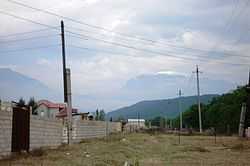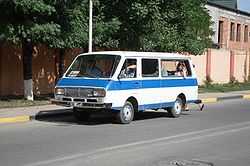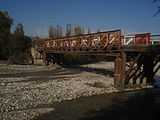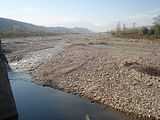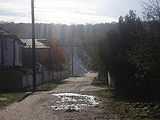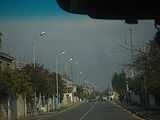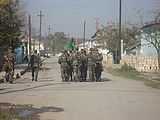Qusar (city)
Coordinates: 41°25′35″N 48°26′08″E / 41.42639°N 48.43556°E
| Qusar | ||
|---|---|---|
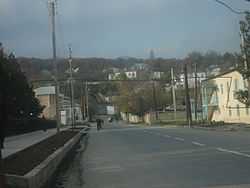 | ||
| ||
 Qusar | ||
| Coordinates: 41°25′35″N 48°26′08″E / 41.42639°N 48.43556°E | ||
| Country |
| |
| Rayon | Qusar | |
| Established | 1938 | |
| Elevation | 667 m (2,188 ft) | |
| Population (2012)[1] | ||
| • Total | 17,400 | |
| Time zone | AZT (UTC+4) | |
| • Summer (DST) | AZT (UTC+5) | |
| Area code(s) | +994 138 | |
| Website | http://kусар.com/ind.php | |
Qusar (also, Kusary) (Azerbaijani: Qusar, Lezgian: Кцlар) - is a city in and the capital of the Qusar Rayon of Azerbaijan. Qusar is located in foothills of Greater Caucasus, over the Qusarchay River, 35 kilometers to south-west from Khudat railway station and 180 km far from Baku.
History
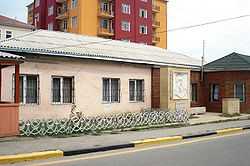
In 1836, Mikhail Yuriyevich Lermontov visited Qusar, where he met with Haji Ali-efendi – a scientist-philosopher and there he heard “Ashiq Qarib” dastan from an eminent ahiq Lazgi Ahmad and after he wrote his famous work “Ashiq Qarib” based on its motifs. A home-museum of the poet is reserved in the city with a memorial plate, where are written famous lines of Lermontov:
|
I welcome you, the hoary Caucasus! |
In 1938, Qusar settlement acquired a city status.[3]
Etymology
There exist many versions about origination of the city, but the most possible one is a version of Tamilla Khalilova – Candidate of History. Since the 7th century, conquest of the South Caucasus by Arabs began. According to historical data the Arabs reached a territory of present Qusar Rayon. According to the historians version name of the river is originated from Arabian Al-Qausar. In translation from the Quran into English “Al_Qausar – in translation means a river of abundance, that is a heaven river, water of which is whiter than milk and sweeter than honey. Its fragrance is nicer than musk and birds with beautiful long necks like necks of camels fly around it.”[4] The settlement got its name from the river – Qusar. Modern historians believe that the name Qusar derives from khisar.[5]
Geography and climate
Qusar is located in a zone of subtropical climate and the northern part of the rayon is in zone of mild climate. But because of the heights above the sea level and proximity of the mountains winter is always cold here, and summer is not hot. Temperature of air can change more than 15 degrees during a day. For instance, in summer incessant days-long rains can begin after hot weather.
The city is located not far from Bazarduzu, Shahdagh Mountains and a border with Russia. The mountain river Qusarchay, in honor of which the city acquired its name, flows in Qusar.[6] There is also is an artificial lake - Violet.
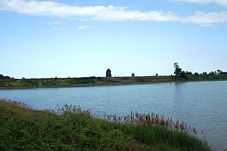
Economy

The economy of Qusar is partially agricultural, partially tourist based, with some industries in operation. There are tinned food, milk and asphalt factories in the city.
Culture and education
In 1998, the State Drama Theatre of Lezghins was opened in Qusar.[7]
In 2008, 6 secondary schools, one of which is functioning in Azerbaijani and 5 in Russian languages, were functioned in the city. There are also two preschool education institutions in the city. There is also Azerbaijan State Pedagogical College, where study future teachers of Azerbaijani, English languages and literature, and also teachers of elementary classes.
Population
According to “The Caucasian calendar” of 1916, there lived 1203 people, generally the Russians,[8] in the territory of Qusar. In 1926, in Qusar lived 120 highland Jews, bit in 1939 – 241 Jews.[3]
According to a census of 1959, more than 7366 people[9] lived in Qusar. According to a census of 1979, population of the city consisted of 12225 people,[10] but in 1989 it reached 14230.[11]
97% of the population consists of Lezghins.
Transportation
Intracity transportation in Qusar is represented by buses RAF-2203 going from city bazaar along the whole city. There are only several intracity buses functioning in daytime. There is a bus station, from where the buses go to Quba, Baku and in the rayon, in the city.
Bridges
- Old bridge
- New bridge
Sports
There is a rock climbing club of Ilqar Israfilov, who is engaged in subjugation of mountains.
Sightseeing
- Nariman Narimanov park
- House of Lermontov
- Square of General Mahmud Abilov
- Local history museum established in 1982. There are 3000 exhibits in the museum.
Famous natives
- Borshev Timofey Mikhaylovich – People’s Commissar of International Affairs of 5the Turkmenistan SSR (1938-1942).[12]
Gallery
-
A school in Qusar with Hedar Aliyev's likeness on the wall
-
Old bridge in Qusar
-
New bridge
-
A mosque
-
Panorama of the city in the evening
-
-
-
-
-
References
- ↑ The State Statistical Committee of the Azerbaijan Republic
- ↑ Кусары 60. Azerbaijan: Communist. 1990. p. 48.
- ↑ 3.0 3.1 Российская еврейская энциклопедия 5. Российская академия естественных наук. p. 248.
- ↑ Смысловой перевод священного Корана на русский язык Кулиева Эльмира
- ↑ The Ministry of Culture and Tourism of Azerbaijan: Gusar city
- ↑ «Чай» на конце названия рек означает «река»: Кусарчай — «Кусарская река»
- ↑ Расим МУСАБЕКОВ. "Становление независимого азербайджанского государства и этнические меньшинства". sakharov-center.ru. Archived from the original on 2012-02-03.
- ↑ Кавказский календарь на 1916 год. Отдел статистический. Tbilisi. p. 24.
- ↑ "Всесоюзная перепись населения 1959 г. Численность городского населения союзных республик (кроме РСФСР), их территориальных единиц, городских поселений и городских районов по полу". Демоскоп Weekly.
- ↑ "Всесоюзная перепись населения 1979 г. Численность городского населения союзных республик (кроме РСФСР), их территориальных единиц, городских поселений и городских районов по полу". Демоскоп Weekly.
- ↑ Демоскоп Weekly - Электронная версия бюллетеня Население и общество. "Всесоюзная перепись населения 1989 г." (in Russian). Институт демографии Государственного университета - Высшей школы экономики. Archived from the original on 2012-02-04. Retrieved 2010-09-22. Unknown parameter
|description=ignored (help) - ↑ Кто руководил НКВД, 1934-1941: справочник. Zvenʹi︠a︡. 1999. p. 114. ISBN 9785787000320.
External links
- '32FA8814FDBD3774E0440003BA962ED3'&Diacritics=DC Qusar at GEOnet Names Server
- World Gazetteer: Azerbaijan – World-Gazetteer.com
| Wikimedia Commons has media related to Kusary. |

